
I am an enthusiast for newspapers’ attempts at innovation in the pre-internet age. They had a window and they made plenty of attempts, but they let that window close just before it led anywhere good. In recent years, the most innovative newspaper, coverage left off to the side, has probably been The New York Times, followed directly by The Washington Post. Often, attempts to innovate in newspapers end up like the Wikitorial — embarrassing for all involved, but thankfully forgotten quickly.
But in 1982, true innovation and success was to be found in the form of USA Today. It was easily the most experimental paper of its kind when it first came out, and that early experimentation paid off as Gannett’s daily newspaper became a mainstay of hotels and newspaper racks throughout the United States. The paper recently celebrated its 40th anniversary, a huge feat. I have heard complaints from many editors over the years about the paper’s writing style, but the fact of the matter is, it was hugely popular in its early days. But did you know it had its own CompuServe-like online service…just for sports? I learned this by literally buying a software package that appeared on my front door almost exactly on the paper’s 40th anniversary.
The number of daily readers USA Today counted in its audience in 1989, according to one estimate offered by the paper from the period. By comparison, the paper, which sold a Labor Day issue in 1989 with a circulation of 2.33 million, averages a paid daily circulation of around 150,000 today, according to a Poynter article in May. (The company’s traditional strong suit of free copies at hotels shrank significantly during the pandemic, though a bounce-back is expected.)
Why did USA Today create an online service only for sports fans?
In 2006, one of the most memorably bad ideas to emerge from Bristol, Connecticut came to life in the form of Mobile ESPN, a service that aimed to convince people to sign up for a specialized mobile phone service, at a time when it was hard to imagine subscribing to a mobile company dominated by one brand. At the time, most people already owned a phone, and they weren’t going to shell out extra for one that shouted sports scores at you.
It looked like a better idea in retrospect, but it was still a pretty shaky concept when it first launched — a dedicated service built around sports, with the assumption that sports fans would pay for dedicated coverage. It’s not that they were wrong, but the motivation that gets people to engage with sports content is not the same as what gets people to buy a cell phone.
Later on, it became clear that ESPN was onto something by putting energy into its digital presence, but its initial vessel for that idea? Not great.
I’m sure the same line of thinking was what drove USA Today’s owners, Gannett, to create a sports-centric online service for its readers.
At the time when they were making this, there was evidence that there might be a market for a broad niche in sports-driven content.
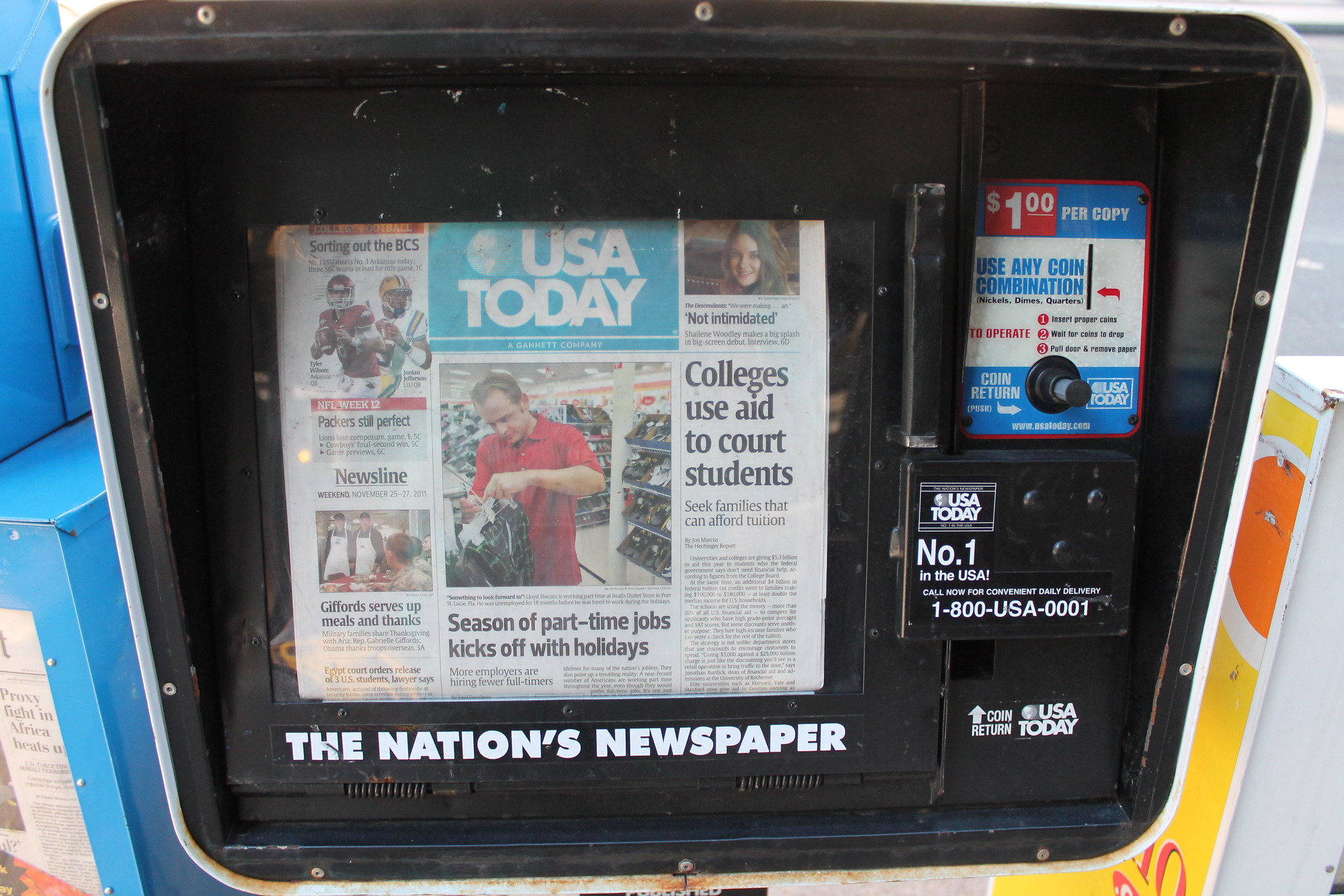
Fantasy football, a concept that had slowly gained momentum in the 1960s and 1970s, began to flourish thanks to the added access to information encouraged by cable sports and primitive online services. Rotisserie League Baseball, founded in the early 1980s, helped to build popular interest in the statistics-driven fantasy sports, as did access to national-minded sports information encouraged by publications such as USA Today. Heck, in the early ’90s, there was even a daily newspaper dedicated entirely to sports, The National — a noble failure that many a newsroom lifer laments.
A pair of Washington media personalities moonlighting as syndicated computer columnists, Brit Hume (yes, that Brit Hume) and T.R. Reid (no, not that T.R. Reid), put the value proposition of USA Today’s moonlight into digital sports services like this:
The “generalized” on-line services, like CompuServe and Prodigy, are engaged in broadcasting — appealing to the broadest possible range of interests with an expansive menu of categories.But the up-and-coming wave in this electronic sea is the “specialized on-line service,” which ties to fill one need extremely well. Such outfits are “narrowcasting” — targeting carefully at doctors, lawyers, teachers or other niche of the population. This is the computerized version of cable TV.
As I’ve written in the past, this kind of narrow targeting of media happens across a lot of industries, including radio and niche publishing, but the difference at this time was that to build a narrowly tailored online service, you actually needed to effectively run your own BBS, maybe leveraging the backhaul of time-sharing networks to support your reach. In the era before the internet had truly broken out of academia, it was tough to get the proper reach, but if you were into a niche hobby like fantasy football or baseball, you might be willing to pay a few extra bucks.
Online services targeted at those with strong information needs were not unheard of during this period, either — as I have written in the past, The Wall Street Journal had an dial-in online resource for news clippings way back in 1974, and many major newspapers essentially threw their content at CompuServe in the early ’80s simply because CompuServe asked.
And because of the broad readership of USA Today (reportedly 5.3 million people daily in the late 1980s), it made for an effective upsell. If you’re into sports but you find the information in the pages of this newspaper not quite enough, here’s an online resource that can cover your need for the latest sports scores.
Announced in February 1989, the service was described as such:
USA TODAY Sports Center members will have a wide range of services at their fingertips. These include: complete statistics for professional sports, schedules for professional and college sports, personalized news statistics and scoreboards on a favorite team or player, team-by-team statistical matchups, the latest breaking sports news and scores from a live ticker wire, and national Fantasy Rotisserie league games for baseball, football, basketball and hockey.Members also can trade, buy and sell baseball cards, chat with each other or USA TODAY Sports experts, purchase authentic professional sportswear and play board games, including international chess games and tournaments, checkers, go, reversi and blackjack.
So this was a network built for sports nuts, fantasy sports fans, and those who want to play some kind of online games. It wasn’t the only one of its kind, as anyone who has ever used BIX or The Well can attest, but it did play to the idea that there would be a small portion of USA Today’s audience that could be upsold.
And upsold they were, with frequent references to the service appearing in the pages of the newspaper. Those who ended up buying into the concept of a specialized online service just for sports fans found something that was very much not cheap.
The maximum cost per hour to dial into USA Today Sports Center, depending on the number. Dialing in via a secondary network like Tymnet or Telenet, the most common options during the period, cost around $4.95 during “leisure time” (between 6pm and 6am), but $14.95 per hour during “business time” (between 6am and 6pm). Direct dialing was the cheapest option, but unless you were local, it would likely lead to additional charges. For most people the likely cost would be $4.95 per hour, equivalent to $11.82 today when accounting for inflation. A mere seven years after this service was launched, it was possible to get unlimited dial-up internet for $20 a month.
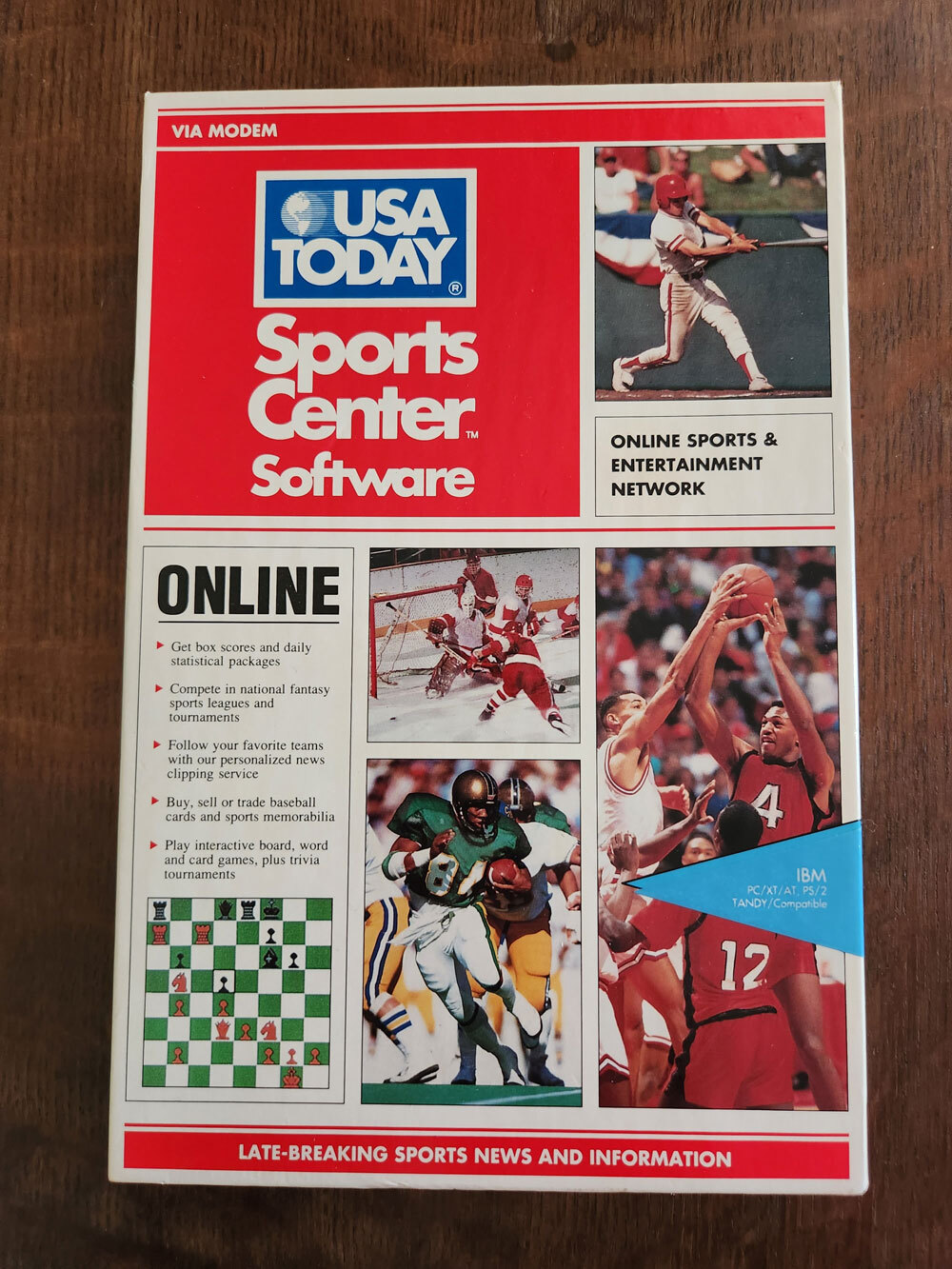
When I spotted this, I knew I had to write about it.
USA Today Sports Center (no relation to the iconic ESPN show) is quite the time capsule of a very specific time, a period in which a newspaper believed it could convince people to pay five bucks an hour to log onto their service during the big game.
Realistically, most people were probably not logging on for hours on end, and were likely downloading scores every once in a while, which means that, unless you were caught up in an online reversi league you couldn’t get out of, odds are you weren’t spending $5 an hour for the honor. It was too much of a luxury to really use in the way we use online services today. No falling asleep to ticker-tape messages from the USA Today Sports Center online service unless you wanted an embarrassingly large credit card bill at the end of the month.
You didn’t technically need this software package to join this network. In many ways, it was like a standard bulletin-board service, in that all you really needed was access to a terminal. Dialing in via USA Today’s own software package was totally optional.
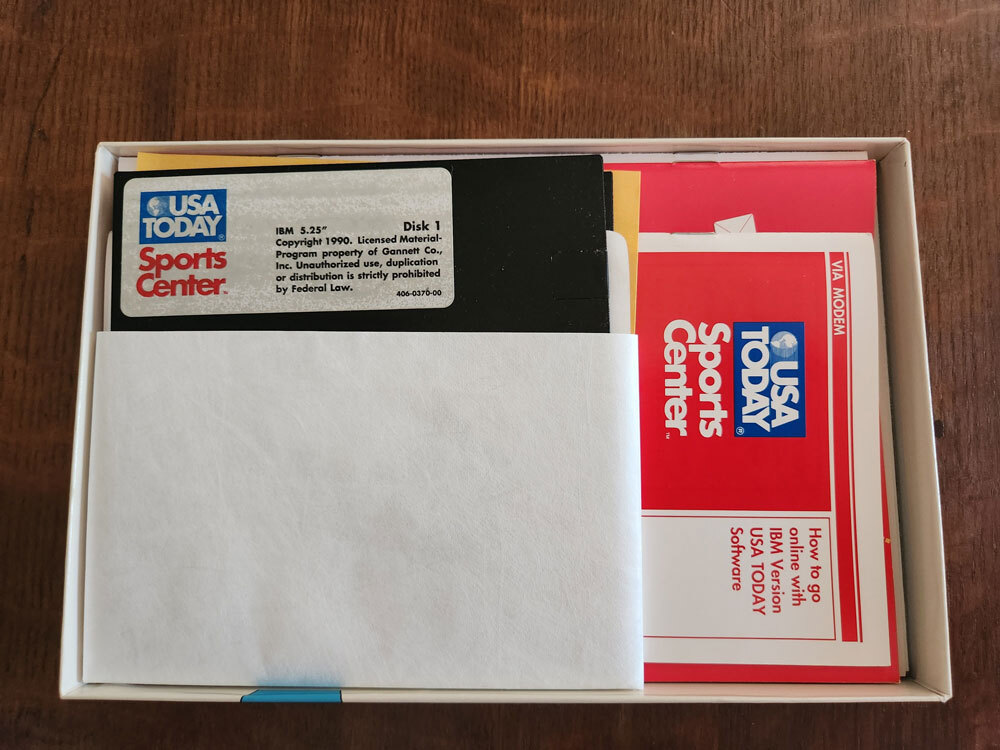
Before I spotted this on ShopGoodwill about two weeks ago, it had been shrinkwrapped in a box for about 32 years.
But if you did, it was quite the expensive endeavor. On top of the per-hour access, you were also charged a membership fee for starting access to the service, a monthly fee for simply getting online, and then the additional charges based on when you logged in. You also needed a modem, purchased separately. Online services of the era did a really great job of charging you multiple times to access the same thing.
So obviously, I can’t access this service today, but what can I do with it? Well, I have an old computer with a 5 and 1/4-inch floppy drive that runs DOS. I set the machine up a while ago to be able to accept an SD card, meaning that I can literally take the SD card out, load the disk into a modern emulator like DOSBox, and analyze the files.
Which meant that I had to open up the box. And my lord, on the inside of this box were materials that had not seen the light of day in 32 years. The labels on the floppy disks had faded over time, with the adhesive giving them a slightly grungy appearance, but the manuals were in pristine condition, looking every bit as impressive as an issue of USA Today from the era did. The Online Preview booklet in particular felt surprisingly modern for something that existed to convince you that you were making the right choice by installing this on your 386.
And while the famed software manufacturer Data East is not mentioned on the box anywhere, it had a clear role in publishing the product, as highlighted by the fact that the box includes a manual of the company’s latest products, reproduced elsewhere online, that highlighted the company’s then-current lineup of games for various computers and consoles, including its ports of the legendary arcade games BurgerTime and Rampage.
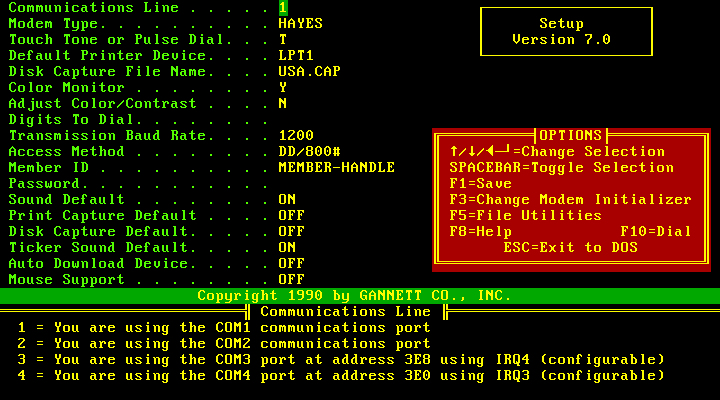
USA Today Sports Center, as it appears in DOSBox. Obviously, it’s going to be hard to get an outside line to dial in to Tymnet.
The network itself was managed by a North Carolina company called Linc Networks, but Gannett appears to have had a role in programming the software, as the copyright on the program is credited to them, rather than Linc.
My goal is to ultimately post all of this stuff to the Internet Archive, because it’s a lot of good material and it highlights an era of the newspaper industry that hasn’t been properly documented online. My hope was to see if I could find any graphical or data assets that could be reproduced, along the lines of what Benj Edwards and others have helped to do with the online service Prodigy, but after a few attempts to load the .VGA image files using tools that could supposedly read .VGA files, I got nothing.
In my efforts to revive a little digital history in honor of USA Today’s 40th anniversary, I ran into a hiccup, however.
The final year I can find mentions of USA Today Sports Center online, at which point the mentions simply told you where to call, rather than trying to sell you on a software package. That same year, USA Today launched USA Today Online, the first general-purpose online platform the newspaper operated. Eventually, it would gain the name USAToday.com, which is still active today. USA Today Sports Center is not mentioned on the newspaper’s own timeline, despite being the paper’s first foray into the online world.
I don’t get to open up a lot of old shrink-wrapped boxes of software. Usually my rule is that if a box is shrink-wrapped, unless the object is common or of significant cultural value, I try not to open it.
I felt that in this case, USA Today Sports Center fit the bill as something worth opening. It is culturally relevant, highlighting a bold attempt by a newspaper at the height of its influence to drive a new kind of conversation in a new medium, and doing so with the business model at the front of the conversation, rather than the back. And given that USA Today just celebrated a milestone, the time was right.
Plus, there are still shrink-wrapped copies to be found on eBay for not that much money, in case you want one of your own. If for some reason, you feel like the sanctity of this object has been damaged by my decision to break the plastic seal, I apologize.
But given the price range and the fact that it was promoted in one of the largest newspapers in the country for probably five years straight, we are likely not looking at something that only sold only a handful of copies. Maybe it’s not quite AOL coaster scale, but odds are we have a good chance of finding additional copies.
Still though, as I was opening, I realized both the risk and the opportunity of what this endeavor could offer. I have one 5 1/4 floppy drive at my disposal, and it still works. The problem is, though, that it’s 30-year-old technology, and even doing something as basic as running a program on a machine that came out when the first George Bush was president comes with a degree of inherent risk.
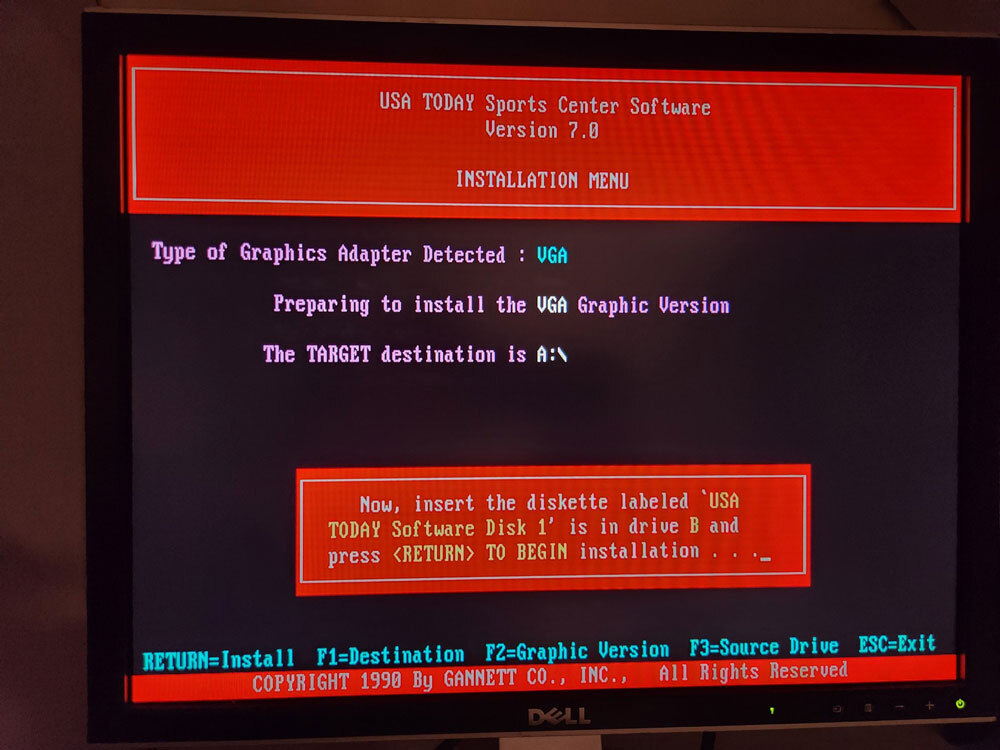
The only evidence I have that I actually got the installer to load, besides the installed program itself.
And that risk showed itself in a sad, scary way when I tried loading this software onto a real computer in an effort to preserve it. I successfully installed the program onto my drive, so we have an executable and the available software. But the problem was, when I went to copy the contents of the disk onto my SD drive, it didn’t work — I got the dreaded “Abort, Retry, Fail” disk error.
There was no recovering. Not even after multiple tries. I think my floppy drive scratched the disk—an absolute utter nightmare for someone simply trying to tell you the story of an object. I haven’t gone to the depths of doing something disk-doctory to repair it, but I effectively opened up a time capsule, successfully ran the program inside just once, and then my own equipment destroyed it. Had I done things in the opposite order—backing up first, then installing — I would have recovered the program.
Even doing the right things comes with inherent risks, and I’m kind of beside myself that this happened. I didn’t take a Dremel to a power supply, sort of the most infamous recent example of retro-restoration-gone-wrong, but my attempt to save the data on this disk backfired in a big way. What heartbreak. I’ll see what can be done after I hit publish on this post.
OK, let’s take a deep breath after that revelation. I’m sorry I have to tell you that, but given that this happened, I owe it to you as readers, I guess.
As a cultural item, this tells a fascinating, interesting story. Was the model of USA Today Sports Center out of date almost immediately after it was launched? Sure. Was it a tool for die-hard sports fans? You got it. Was it a smart business idea for an era when online was more expensive novelty than common tool? Absolutely.
But I’m glad USA Today tried it. Maybe it didn’t dominate the modems of the world, but it wasn’t as embarrassing a failure as, say, Mobile ESPN. In an era when you put a floppy disk into a drive once and the drive attacks the disk, you gotta take the optimism where you can get it.
Ernie Smith is editor of Tedium, a twice-weekly offbeat digital newsletter that mines the depths of the long tail in search of obscurities, and where a version of this piece first appeared.